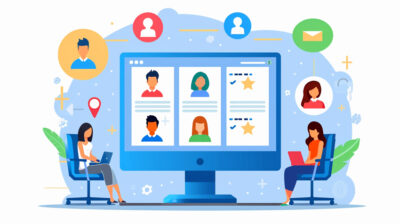Creating an effective employee development plan is essential for organizations that want to support employee growth and career advancement. An employee development plan is a roadmap for employees that outlines their goals, identifies areas for improvement, and provides a clear path for career advancement.
In this blog post from Top Echelon Recruiting Software we’ll discuss how to create an effective employee development plan, including tips for supporting employee growth and career advancement.
What is an Employee Development Plan?
An employee development plan is a document outlining the specific goals, objectives, and activities an employee will undertake in order to enhance their skills, knowledge, and abilities. It is a tool used by organizations to support the professional growth and development of their employees, and to ensure that they have the necessary skills and competencies to meet the changing needs of the organization.
An employee development plan typically includes a series of objectives or goals that the employee is expected to achieve, as well as specific activities or training programs that will help them meet those goals. The plan is developed in collaboration between the employee and their manager or supervisor, and is based on the employee’s career aspirations and the organization’s strategic objectives.
The objectives included in an employee development plan can be focused on a variety of areas, such as improving job-related skills, developing leadership abilities, or gaining new knowledge and experience. The plan may include a mix of on-the-job training, mentoring, coaching, classroom instruction, and other forms of professional development.
Importance of an Employee Development Plan
An employee development plan is not just a checklist of training programs; it is a strategic tool that helps align the career aspirations of employees with the organizational goals. This alignment is crucial because it ensures that employees are working towards objectives that benefit both their personal growth and the company’s success.
A well-crafted employee development plan helps in creating a culture of continuous learning and improvement. It encourages employees to take charge of their own development, thus increasing their engagement and commitment to the organization. Additionally, by providing a clear path for career advancement, it helps in retaining top talent and reducing turnover.
How to Create an Employee Development Plan
Creating an effective employee development plan involves several steps. Each step is crucial for ensuring that the plan is tailored to the individual needs of the employee while aligning with the broader goals of the organization.
Conduct a Skills Assessment
The first step in creating an effective employee development plan is to conduct a skills assessment. This involves identifying the skills and competencies that employees need to succeed in their current roles and advance in their careers. A skills assessment can be conducted through a variety of methods, including performance reviews, skills tests, and self-assessments.
Performance Reviews
Performance reviews are a traditional method for assessing an employee’s skills and competencies. During these reviews, managers evaluate the employee’s performance against established criteria and provide feedback on areas of strength and areas needing improvement.
Skills Tests
Skills tests are more specific and can help identify particular competencies that an employee may need to develop. These tests can range from technical assessments to behavioral evaluations, depending on the nature of the job.
Self-Assessments
Self-assessments involve employees evaluating their own skills and competencies. This method encourages employees to reflect on their strengths and weaknesses, providing valuable insights into their own development needs.
Set Clear Goals
Once you have identified the skills and competencies that employees need to develop, the next step is to set clear goals. Goals should be specific, measurable, achievable, relevant, and time-bound (SMART). This ensures that employees have a clear understanding of what they need to achieve and by when.
Specific Goals
Goals should be clearly defined and focused. Instead of setting a vague goal like “improve communication skills,” a more specific goal would be “attend a communication workshop and practice new techniques in team meetings.”
Measurable Goals
Measurable goals provide a way to track progress. For example, instead of “increase sales,” a measurable goal would be “increase sales by 10% within the next six months.”
Achievable Goals
Goals should be realistic and attainable. Setting overly ambitious goals can lead to frustration, while setting goals that are too easy can lead to complacency.
Relevant Goals
Goals should align with the employee’s role and the organization’s objectives. This ensures that the employee’s efforts contribute to the overall success of the organization.
Time-Bound Goals
Goals should have a clear deadline. This creates a sense of urgency and helps employees stay focused on achieving their objectives.
Provide Training and Development Opportunities
To support employee growth and development, organizations should provide training and development opportunities. This can include on-the-job training, mentoring, coaching, and formal training programs. It is important to provide employees with the resources and support they need to develop the skills and competencies identified in their employee development plan.
On-the-Job Training
On-the-job training involves learning by doing. Employees gain practical experience and develop skills directly related to their roles.
Mentoring
Mentoring involves pairing employees with more experienced colleagues who can provide guidance and support. Mentors can share their knowledge and experience, helping mentees navigate their career paths.
Coaching
Coaching is a more structured form of support where a coach works with an employee to develop specific skills or achieve particular goals. Coaches can provide valuable feedback and help employees stay accountable.
Formal Training Programs
Formal training programs can include workshops, seminars, and courses that provide employees with the knowledge and skills they need to advance in their careers. These programs can be conducted in-house or through external providers.
Offer Job Shadowing and Cross-Training Opportunities
Job shadowing and cross-training opportunities can provide employees with exposure to different roles and departments within the organization. This can help employees develop a broader range of skills and competencies and increase their understanding of the organization as a whole.
Job Shadowing
Job shadowing involves observing another employee in their role. This provides valuable insights into different job functions and can help employees understand how various roles contribute to the organization’s success.
Cross-Training
Cross-training involves teaching employees how to perform tasks outside of their usual responsibilities. This not only enhances their skill set but also increases organizational flexibility by creating a more versatile workforce.
Provide Regular Feedback
Providing regular feedback is essential for supporting employee growth and development. Feedback should be constructive, specific, and focused on helping employees achieve their goals. Regular feedback can be provided through one-on-one meetings, performance reviews, and informal conversations.
Constructive Feedback
Constructive feedback focuses on specific behaviors and provides actionable suggestions for improvement. For example, instead of saying “you need to be more proactive,” a more constructive approach would be “you could take the initiative by identifying potential issues and proposing solutions.”
Specific Feedback
Specific feedback is clear and detailed. Instead of general comments like “good job,” specific feedback would be “your presentation was well-organized and clearly communicated the project’s objectives.”
Ongoing Feedback
Ongoing feedback ensures that employees receive timely guidance and support. Regular check-ins and informal conversations can help address issues as they arise and keep employees on track to achieve their goals.
Encourage Networking and Collaboration
Encouraging networking and collaboration can help employees develop relationships with colleagues and build their professional networks. This can provide opportunities for knowledge sharing, mentoring, and career advancement.
Networking
Networking involves building professional relationships both within and outside the organization. Attending industry events, joining professional associations, and participating in online forums can help employees expand their networks.
Collaboration
Collaboration involves working with colleagues to achieve common goals. Encouraging teamwork and cross-functional projects can enhance employees’ problem-solving skills and foster a sense of community within the organization.
Recognize and Reward Employee Achievements
Recognizing and rewarding employee achievements can motivate employees to continue to develop their skills and competencies. Rewards can be financial or non-financial, such as public recognition or additional responsibilities.
Financial Rewards
Financial rewards can include bonuses, salary increases, and other monetary incentives. These rewards can provide tangible recognition of employees’ hard work and achievements.
Non-Financial Rewards
Non-financial rewards can include public recognition, additional responsibilities, and opportunities for career advancement. These rewards can enhance employees’ job satisfaction and motivation.
Provide Career Development Opportunities
Providing career development opportunities is essential for supporting employee growth and advancement. This can include opportunities for promotion, lateral moves, and special projects. Organizations should have a clear career development path for employees that outlines the skills and competencies required for each level.
Promotion Opportunities
Promotion opportunities involve advancing to higher-level positions within the organization. These opportunities provide employees with new challenges and responsibilities, motivating them to continue developing their skills.
Lateral Moves
Lateral moves involve transferring to different roles at the same level within the organization. These moves can help employees gain new experiences and develop a broader skill set.
Special Projects
Special projects involve working on unique or high-priority initiatives. These projects can provide valuable learning experiences and help employees demonstrate their capabilities.
Review and Revise the Plan Regularly
An employee development plan should be reviewed and revised regularly to ensure that it remains relevant and effective. This can be done through regular performance reviews and goal-setting sessions. Employees should be encouraged to provide feedback on their development plans and suggest areas for improvement.
Regular Performance Reviews
Regular performance reviews provide an opportunity to assess progress and make adjustments to the development plan. These reviews should include a discussion of achievements, challenges, and future goals.
Goal-Setting Sessions
Goal-setting sessions involve revisiting and updating the goals outlined in the development plan. These sessions ensure that the plan remains aligned with the employee’s career aspirations and the organization’s objectives.
Employee Development Plans: a ‘Win-Win’
Creating an effective employee development plan is essential for organizations that want to support employee growth and career advancement. A successful employee development plan should include a skills assessment, clear goals, training and development opportunities, regular feedback, networking and collaboration, recognition and rewards, career development opportunities, and regular review and revision. By implementing these tips, organizations can create a culture of learning and growth that supports employee development and drives business success.
An effective employee development plan not only enhances individual performance but also contributes to the overall success of the organization. By investing in employee development, organizations can build a skilled, motivated, and engaged workforce that is capable of meeting the challenges of a rapidly changing business environment. Through continuous learning and improvement, employees can achieve their full potential, and organizations can achieve their strategic goals.








